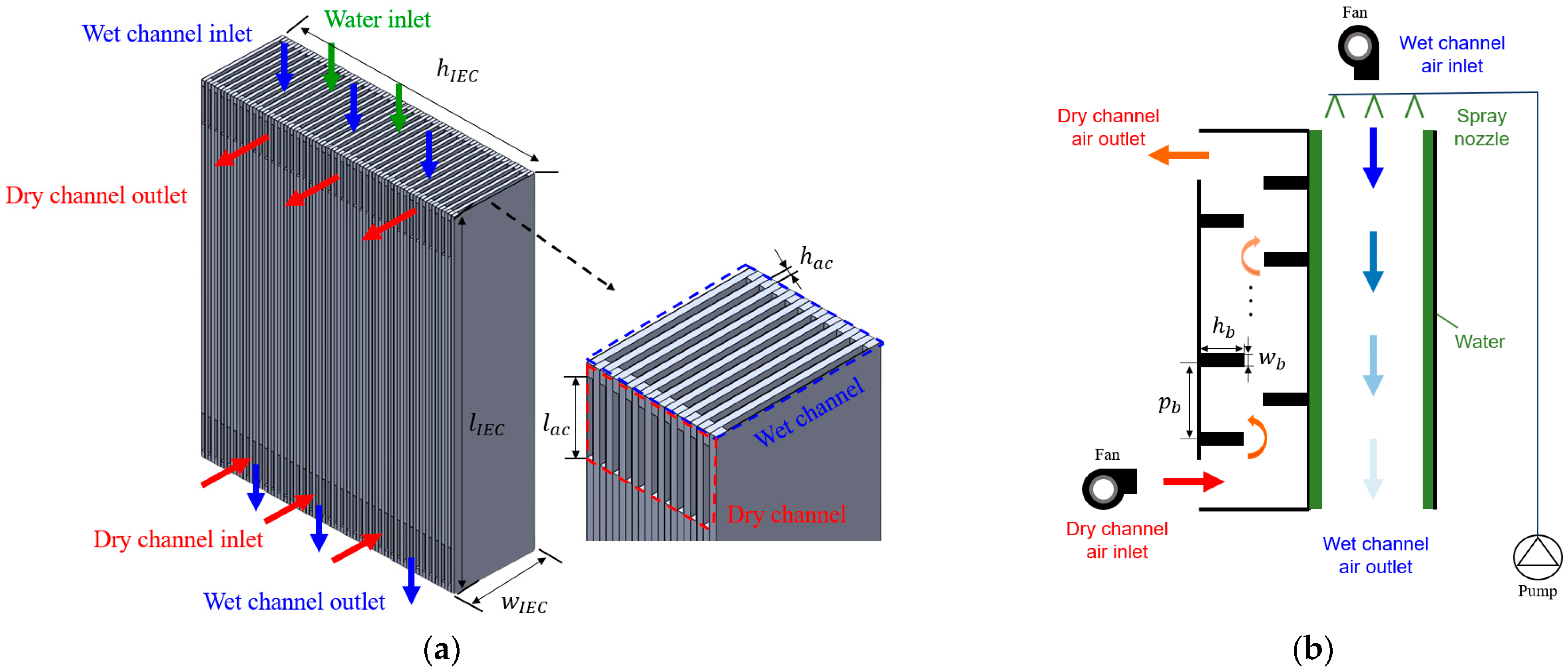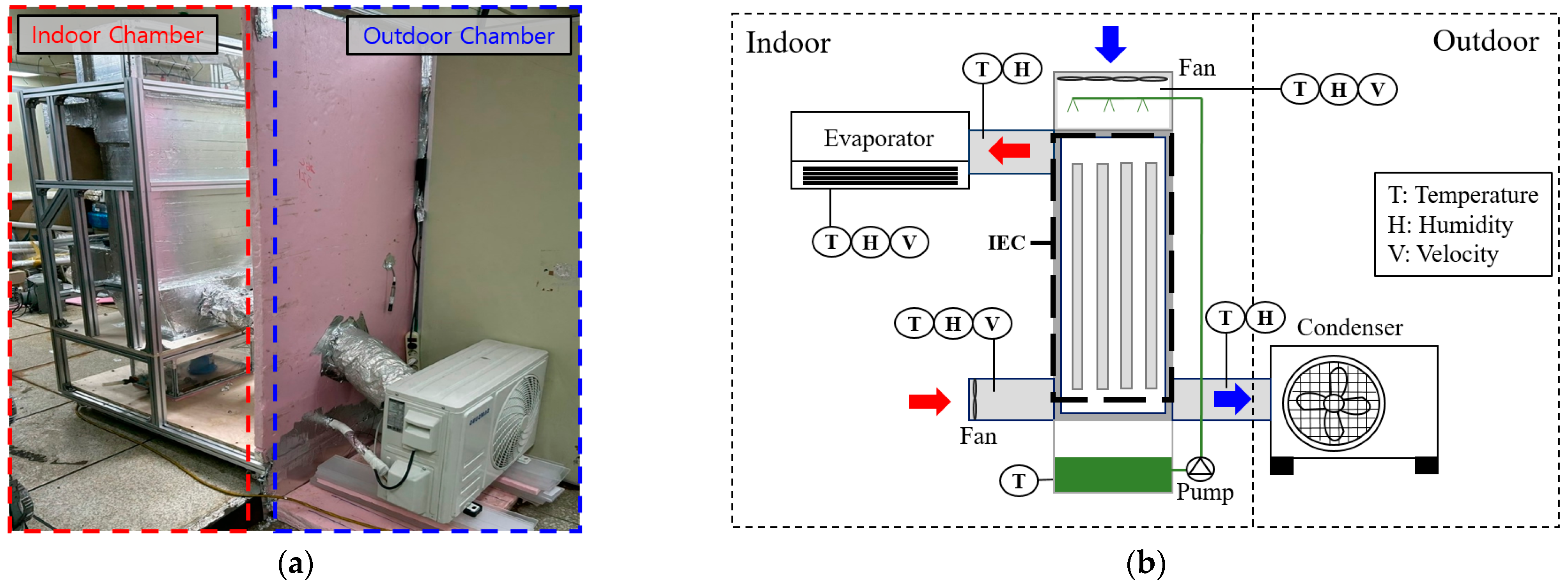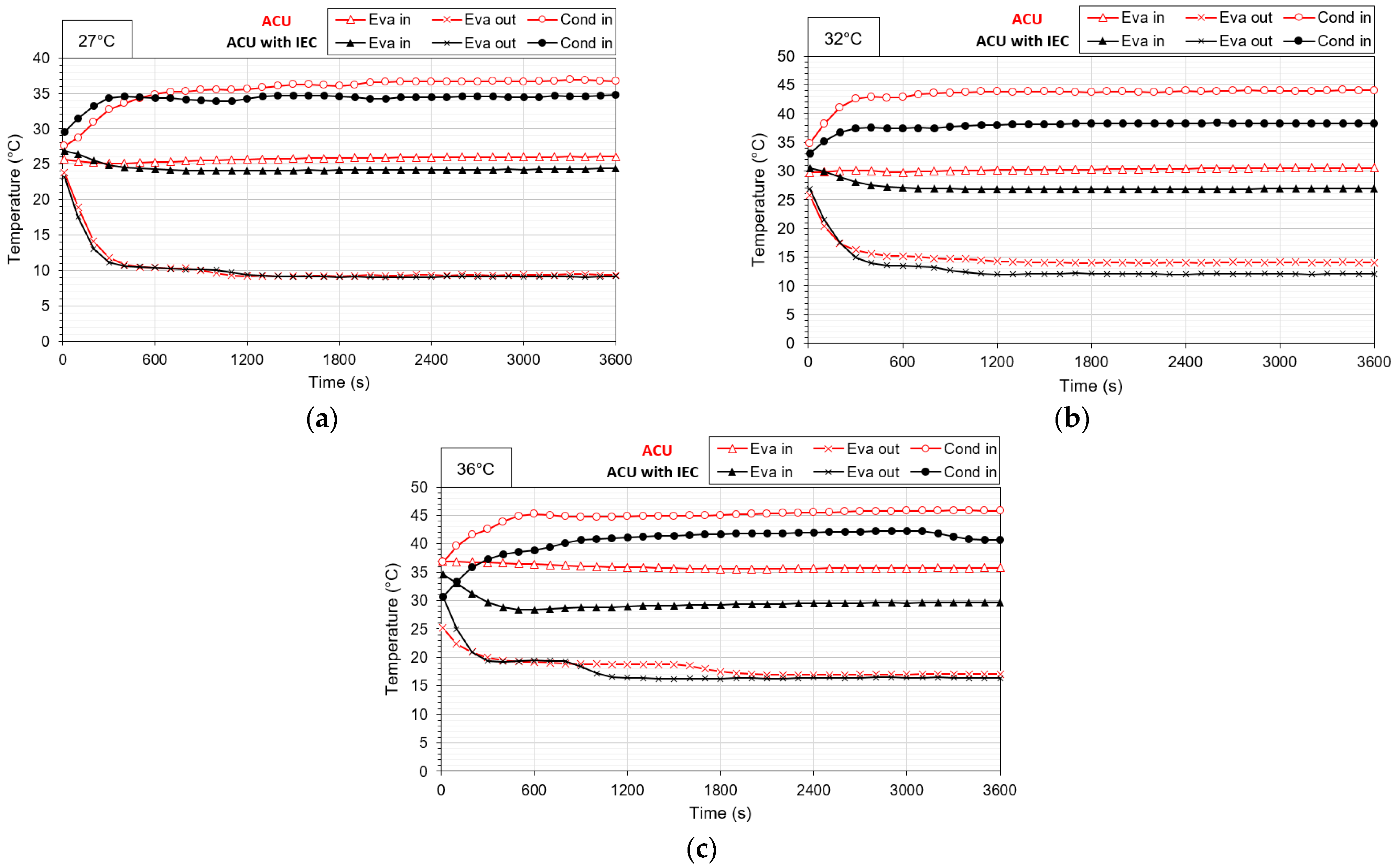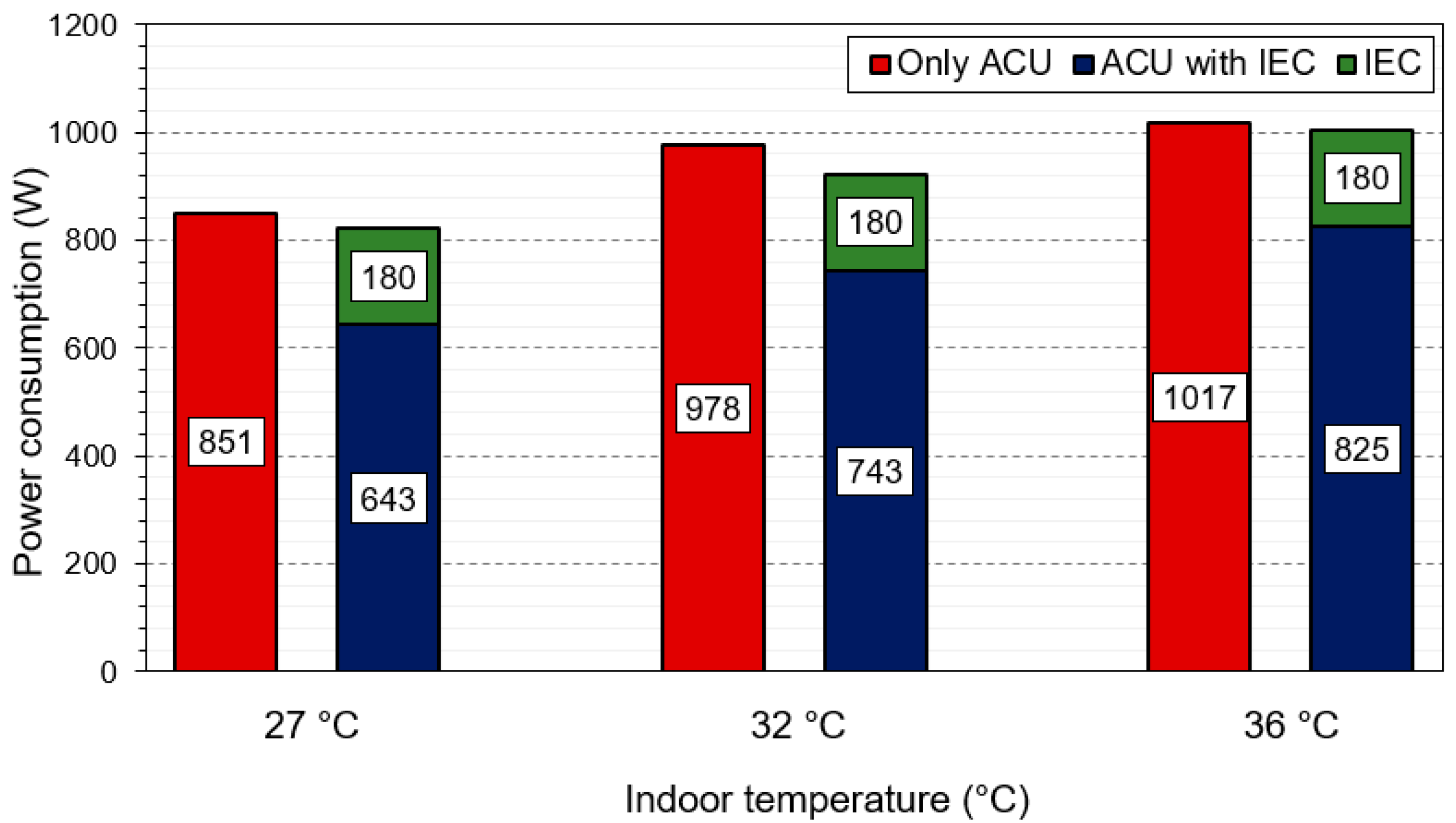Experimental Study on the Performance of an Air Conditioning Unit with a Baffled Indirect Evaporative Cooler
Abstract
1. Introduction
2. Experimental Apparatus and Method
2.1. Description of Baffled IEC
2.2. Description of ACU with Baffled IEC
2.3. Experimental Setup
2.4. Performance Indices
2.5. Uncertainty Analysis
3. Results and Discussion
3.1. Performance of IEC
3.2. Performance of IEC with AC
3.2.1. Temperature Difference
3.2.2. Cooling Capacity
3.2.3. Power Consumption
3.2.4. COP
4. Conclusions
- (1)
- The average air temperatures at the evaporator inlet, evaporator outlet, and condenser inlet of the ACU with the IEC were lower than those of the ACU alone, under all indoor temperature conditions during the test period.
- (2)
- The average total cooling capacity of the ACU integrated with the IEC increased by 0.4%, 13.1%, and 5.7% at 27 °C, 32 °C, and 36 °C, respectively, compared to the ACU alone.
- (3)
- The average total power consumption of the ACU with the IEC decreased by 3.20%, 8.60%, and 1.13% at 27 °C, 32 °C, and 36 °C, respectively, compared to the ACU alone.
- (4)
- The average COP of the ACU with the IEC was 2.13, 2.08, and 1.92 at 27 °C, 32 °C, and 36 °C, respectively, compared to 2.06, 1.74, and 1.79 for the ACU alone, indicating increases of 3.42%, 19.5%, and 7.39%.
Author Contributions
Funding
Data Availability Statement
Conflicts of Interest
Abbreviations
| Nomenclature | |
| Area (m2) | |
| Temperature (°C) | |
| Height (m) | |
| Length (m) | |
| Mass flow rate (kg/s) | |
| Pitch (m) | |
| t | Thickness (m) |
| Width (m) | |
| Mass flow rate (kg/s) | |
| Heat capacity (J/kg·K) | |
| Relative humidity (%) | |
| Cooling capacity (W) | |
| Power consumption (W) | |
| Coefficient of performance (-) | |
| Subscripts | |
| Air | |
| Air channel | |
| Air conditioning unit | |
| Baffle | |
| Dry channel | |
| Evaporator | |
| Fan | |
| Inlet | |
| Outlet | |
| Pump |
References
- Campaniço, H.; Soares, P.M.M.; Hollmuller, P.; Cardoso, R.M. Climatic Cooling Potential and Building Cooling Demand Savings: High Resolution Spatiotemporal Analysis of Direct Ventilation and Evaporative Cooling for the Iberian Peninsula. Renew. Energy 2016, 85, 766–776. [Google Scholar] [CrossRef]
- González-Torres, M.; Pérez-Lombard, L.; Coronel, J.F.; Maestre, I.R.; Yan, D. A Review on Buildings Energy Information: Trends, End-Uses, Fuels and Drivers. Energy Rep. 2022, 8, 626–637. [Google Scholar] [CrossRef]
- Santamouris, M. Cooling the Buildings—Past, Present and Future. Energy Build. 2016, 128, 617–638. [Google Scholar] [CrossRef]
- Pescod, D. Heat Exchanger for Energy Saving in an Air-Conditioning Plant. ASHRAE Trans. 1979, 85, 238–251. [Google Scholar]
- Cui, X.; Chua, K.J.; Islam, M.R.; Yang, W.M. Fundamental Formulation of a Modified LMTD Method to Study Indirect Evaporative Heat Exchangers. Energy Convers. Manag. 2014, 88, 372–381. [Google Scholar] [CrossRef]
- Pandelidis, D.; Anisimov, S.; Worek, W.M. Performance Study of Counter-Flow Indirect Evaporative Air Coolers. Energy Build. 2015, 109, 53–64. [Google Scholar] [CrossRef]
- Kabeel, A.E.; Abdelgaied, M. Numerical and Experimental Investigation of a Novel Configuration of Indirect Evaporative Cooler with Internal Baffles. Energy Convers. Manag. 2016, 126, 526–536. [Google Scholar] [CrossRef]
- Chen, Y.; Luo, Y.; Yang, H. A Simplified Analytical Model for Indirect Evaporative Cooling Considering Condensation from Fresh Air: Development and Application. Energy Build. 2015, 108, 387–400. [Google Scholar] [CrossRef]
- Chen, Y.; Yang, H.; Luo, Y. Parameter Sensitivity Analysis and Configuration Optimization of Indirect Evaporative Cooler (IEC) Considering Condensation. Appl. Energy 2017, 194, 440–453. [Google Scholar] [CrossRef]
- Min, Y.; Chen, Y.; Yang, H. Numerical Study on Indirect Evaporative Coolers Considering Condensation: A Thorough Comparison between Cross Flow and Counter Flow. Int. J. Heat Mass Transf. 2019, 131, 472–486. [Google Scholar] [CrossRef]
- Shi, W.; Min, Y.; Chen, Y.; Yang, H. Development of a Three-Dimensional Numerical Model of Indirect Evaporative Cooler Incorporating with Air Dehumidification. Int. J. Heat Mass Transf. 2022, 185, 122316. [Google Scholar] [CrossRef]
- Duan, Z.; Zhan, C.; Zhang, X.; Mustafa, M.; Zhao, X.; Alimohammadisagvand, B.; Hasan, A. Indirect Evaporative Cooling: Past, Present and Future Potentials. Renew. Sustain. Energy Rev. 2012, 16, 6823–6850. [Google Scholar] [CrossRef]
- Porumb, B.; Ungureşan, P.; Tutunaru, L.F.; Şerban, A.; BǍlan, M. A Review of Indirect Evaporative Cooling Technology. Energy Procedia 2016, 85, 461–471. [Google Scholar] [CrossRef]
- Yang, H.; Shi, W.; Chen, Y.; Min, Y. Research Development of Indirect Evaporative Cooling Technology: An Updated Review. Renew. Sustain. Energy Rev. 2021, 145, 111082. [Google Scholar] [CrossRef]
- Sajjad, U.; Abbas, N.; Hamid, K.; Abbas, S.; Hussain, I.; Ammar, S.M.; Sultan, M.; Ali, H.M.; Hussain, M.; Rehman, T.U.; et al. A Review of Recent Advances in Indirect Evaporative Cooling Technology. Int. Commun. Heat Mass Transf. 2021, 122, 105140. [Google Scholar] [CrossRef]
- Mohammed, R.H.; El-Morsi, M.; Abdelaziz, O. Indirect Evaporative Cooling for Buildings: A Comprehensive Patents Review. J. Build. Eng. 2022, 50, 104158. [Google Scholar] [CrossRef]
- Xu, P.; Ma, X.; Zhao, X.; Fancey, K. Experimental Investigation of a Super Performance Dew Point Air Cooler. Appl. Energy 2017, 203, 761–777. [Google Scholar] [CrossRef]
- Chen, Q.; Kum Ja, M.; Burhan, M.; Akhtar, F.H.; Shahzad, M.W.; Ybyraiymkul, D.; Ng, K.C. A Hybrid Indirect Evaporative Cooling-Mechanical Vapor Compression Process for Energy-Efficient Air Conditioning. Energy Convers. Manag. 2021, 248, 114798. [Google Scholar] [CrossRef]
- Wang, J.; Lu, J.; Li, W.; Zeng, C.; Shi, F. Numerical Study on Performance of a Hybrid Indirect Evaporative Cooling Heat Recovery Heat Pump Ventilator as Applied in Different Climatic Regions of China. Energy 2022, 239, 122431. [Google Scholar] [CrossRef]
- Wang, T.; Sheng, C.; Nnanna, A.G.A. Experimental Investigation of Air Conditioning System Using Evaporative Cooling Condenser. Energy Build. 2014, 81, 435–443. [Google Scholar] [CrossRef]
- Kim, B.J.; Jo, S.Y.; Jeong, J.W. Energy Performance Enhancement in Air-Source Heat Pump with a Direct Evaporative Cooler-Applied Condenser. Case Stud. Therm. Eng. 2022, 35, 102137. [Google Scholar] [CrossRef]
- Yan, H.; Chen, Y.; Min, Y. Performance Analysis of Small-Scale Direct Expansion Air Conditioning System with Indirect Evaporative Cooler as Dedicated Ventilator. Build. Environ. 2022, 208, 108603. [Google Scholar] [CrossRef]
- Yan, H.; Chen, Y.; Min, Y.; Pan, Y. An Adaptive Controller Based Dynamic Simulation of Household Air-Conditioner with Indirect Evaporative Cooler as Dedicated Outdoor Air System. Energy Build. 2022, 274, 112454. [Google Scholar] [CrossRef]
- Li, W.; Shi, W.; Wang, J.; Li, Y.; Lu, J. Experimental Study of a Novel Household Exhaust Air Heat Pump Enhanced by Indirect Evaporative Cooling. Energy Build. 2021, 236, 110808. [Google Scholar] [CrossRef]
- Martínez, P.; Ruiz, J.; Cutillas, C.G.; Martínez, P.J.; Kaiser, A.S.; Lucas, M. Experimental Study on Energy Performance of a Split Air-Conditioner by Using Variable Thickness Evaporative Cooling Pads Coupled to the Condenser. Appl. Therm. Eng. 2016, 105, 1041–1050. [Google Scholar] [CrossRef]
- Ketwong, W.; Deethayat, T.; Kiatsiriroat, T. Performance Enhancement of Air Conditioner in Hot Climate by Condenser Cooling with Cool Air Generated by Direct Evaporative Cooling. Case Stud. Therm. Eng. 2021, 26, 101127. [Google Scholar] [CrossRef]
- Zhang, J.; Diao, Y.H.; Zhao, Y.H.; Zhang, Y.N. An Experimental Study of the Characteristics of Fluid Flow and Heat Transfer in the Multiport Microchannel Flat Tube. Appl. Therm. Eng. 2014, 65, 209–218. [Google Scholar] [CrossRef]









| Ref. | Analysis Method | Apparatus Setup | Highlights |
|---|---|---|---|
| Chen et al. [18] | Experiment and Numerical | IEC + AHU | Experimental study of an IEC operating with room exhaust air in the wet channels and a numerical evaluation of the energy-saving potential of the EC–MVC under a wide range of outdoor air conditions. |
| Li et al. [24] | Experiment | IEC + Ventilator | Experimental study combining the technical advantages of heat recovery in IECs and the evaporative condenser of a ventilator. |
| Wang et al. [19] | Numerical | IEC + Ventilator | Numerical study of a TRNSYS–Matlab model used to evaluate the ventilator’s adaptability in a public building. |
| Wang et al. [20] | Experiment | DEC + ACU | Experimental study conducted on a hybrid DEC–condenser located in an ACU. |
| Martinez et al. [25] | Experiment | DEC + ACU | Numerical study calculating the optimal cooling pad thickness that maximizes the overall ACU performance under different ambient conditions. |
| Ketwong et al. [26] | Numerical | DEC + ACU | Numerical study on the condenser cooling of an ACU by the cool air generated by a DEC to improve air conditioner performance. |
| Kim et al. [21] | Numerical | DEC + ACU | Numerical study investigating the optimal operation strategy of an ACU system with a EDC installed in an office building. |
| Yan et al. [22,23] | Numerical | IEC + ACU | Numerical study of a system that initially cools air drawn from the external environment using an IEC, subsequently integrating it with the evaporator of an ACU. |
| Present study | Experiment | IEC + ACU | Experimental study of a system that integrates an ACU with a baffled IEC, which is simultaneously connected to both a condenser and evaporator. |
| Parameter | Value | |
|---|---|---|
| IEC | Length ( | 900 mm |
| Width ( | 210 mm | |
| Height ( | 600 mm | |
| Air channel | Length ( | 90 mm |
| Height () | 5 mm | |
| Baffle | Height () | 2 mm |
| Width () | 5 mm | |
| Pitch () | 116 mm | |
| Measurement Device | Model | Range | Uncertainty |
|---|---|---|---|
| Temperature and humidity sensor | GHP-100T | 0~70 °C 0~100% (RH) | ±0.75 °C ±2% |
| Anemometer | Kanomax 6531-2G | 0.01~9.99 m/s | ±0.015% |
| Powermeter | PW3336 | 7.5 W~20 kW | ±0.1% |
| Parameter | Uncertainty |
|---|---|
| ±2.26% | |
| ±2.26% | |
| ±0.17% | |
| ±2.27% | |
| ±2.27% | |
| ±2.28% |
Disclaimer/Publisher’s Note: The statements, opinions and data contained in all publications are solely those of the individual author(s) and contributor(s) and not of MDPI and/or the editor(s). MDPI and/or the editor(s) disclaim responsibility for any injury to people or property resulting from any ideas, methods, instructions or products referred to in the content. |
© 2024 by the authors. Licensee MDPI, Basel, Switzerland. This article is an open access article distributed under the terms and conditions of the Creative Commons Attribution (CC BY) license (https://creativecommons.org/licenses/by/4.0/).
Share and Cite
Kim, S.-B.; Moon, K.-A.; Choi, H.-U.; Choi, K.-H. Experimental Study on the Performance of an Air Conditioning Unit with a Baffled Indirect Evaporative Cooler. Energies 2024, 17, 3231. https://doi.org/10.3390/en17133231
Kim S-B, Moon K-A, Choi H-U, Choi K-H. Experimental Study on the Performance of an Air Conditioning Unit with a Baffled Indirect Evaporative Cooler. Energies. 2024; 17(13):3231. https://doi.org/10.3390/en17133231
Chicago/Turabian StyleKim, Seong-Bhin, Kwang-Am Moon, Hwi-Ung Choi, and Kwang-Hwan Choi. 2024. "Experimental Study on the Performance of an Air Conditioning Unit with a Baffled Indirect Evaporative Cooler" Energies 17, no. 13: 3231. https://doi.org/10.3390/en17133231
APA StyleKim, S.-B., Moon, K.-A., Choi, H.-U., & Choi, K.-H. (2024). Experimental Study on the Performance of an Air Conditioning Unit with a Baffled Indirect Evaporative Cooler. Energies, 17(13), 3231. https://doi.org/10.3390/en17133231






